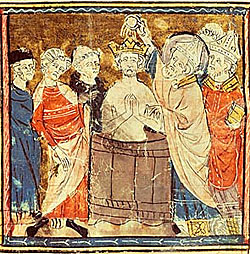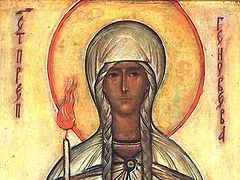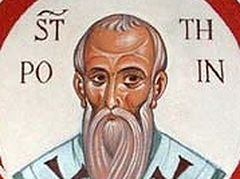 Baptism of Clovis Baptism of Clovis |
| Baptism of Clovis |
3. The Merovingians
Just as monasticism was beginning to put down its roots in Gaul, an event occurred that shook the minds and hearts of the entire Graeco-Roman world: after several centuries of violent conflicts and bloody skirmishes, the Germanic tribes of the north finally sacked the city of Rome. This marked the beginning of a new period in the history of the West, both ecclesiastically and politically, in the challenges it brought to the growing Orthodox Church.
The fusion of the Celto-Roman population in Gaul with the Frankish invaders was facilitated by the conversion of the Frankish King Clovis from Germanic paganism to Orthodoxy in 498, effectively beginning what has come to be known as the Merovingian period in the history of Gaul.
While Clovis’ intentions may have been good, his actions and practices, as well as those of some of his descendants, fell decidedly short of the Christian ideal. But despite the fact that the behavior of the Frankish aristocracy could often be characterized as brutal, Orthodox sanctity had a powerful influence on Merovingian society. Few eras were as fertile in saints. Saints were numerous among the advisors to the kings; some even belonged to the royal families. One can mention King Guntrumnas (called “the Good King”) of Burgundy and especially the holy queens: Clotilde, Radegunde and Bathilde. It was the holy Merovingian queens who really kindled the fire of women’s monasticism in Gaul by founding convents and then joining them shortly before their righteous deaths.
Undoubtedly it was the holy bishops of the 5th and 6th centuries who underwent the most painful struggles. This was due to many causes: the impiety of France’s ever changing rulers, the opposition of many unconverted pagan (or Arian) Germanic peoples who moved into their sees, and the laxness, worldly ambition and mercenary character of some Christian clerics. Nevertheless, great saints shone forth during these centuries, such as the holy hierarchs Remigius of Rheims, Elegius of Noyon, Aldwin of Rouen, Deodatus of Cahors, Leger of Autun and especially Gregory of Tours. St. Gregory wrote much (over twelve volumes) on the history of Gaul and its saints and sinners. It is from him that we know the most about the Merovingian years in Orthodox Gaul.
As the years went by, the Orthodox Christian Faith continued to spread among the people of Gaul. Then, at the end of the 6th century, this process of national conversion received a new impetus from an unexpected source — the monastics and saints of Ireland.
4. The Irish missionaties to the continent
Perhaps the best known exemplar of the Irish monastic missionaries was St. Columbanus of Luxeuil, who initiated these “migrations” to the European continent.
St. Columbanus and his disciples began their journeys in 590, traveling through Brittany into the heart of Frankish Gaul. By the time St. Columbanus arrived, the political and social conditions in Gaul were altogether deplorable. St. Columbanus and his disciples engaged in some itinerant preaching before approaching the aforementioned St. Guntrumnas, King of Burgundy, and receiving permission to establish a monastery. St. Columbanus chose a location far from the court, in the foothills of the Vosges mountains, at a place called Annegray. Shortly afterward two more foundations arose — those of Luxeuil and Fontaines. St. Columbanus was abbot of all three.
For about ten years all went well; the region was deeply and permanently affected by the monasteries and almost all the inhabitants therein were baptized. Then he ran afoul of Queen Brunhilda and was exiled from Burgundy. Though cast out of Burgundy, St. Columbanus was welcomed by other Frankish kings, who were also becoming increasingly alienated from Burgundy. Eventually St. Columbanus and his monks settled at Bregenz, at the eastern end of Lake Constance, in what is now Switzerland. Leaving one of his close disciples there, Columbanus was inspired to preach to the Lombards and crossed the Alps into Italy, eventually settling at Bobbio near the river Po, where he reposed in 615.
Other missionary monastics from Ireland included Sts. Killian, Colman and Totnan of Wurzburg in Germany, St. Gall of Switzerland, St. Ursus of Aosto in Italy, and St. Foillan of the Brabant. Throughout Europe the Irish monks established guest houses for pilgrims and travelers in addition to their monastic hermitages, and wherever they went they brought with them — and continued to produce — works of great beauty. Western Europe had suffered a vast loss of learning from the violence of the preceding centuries. The Irish who came to the Continent carried in their satchels copies of ancient texts, some of which only Irish eyes had seen for centuries. Thus, these monks returned to Europe the lost treasures of classical learning, patristic thought, biblical commentary, and poetry by befriending the barbarian Germanic peoples and then converting them by their love and example.
5. Charlemagne and the beginning of the end
By the end of the 8th century many of the Germanic tribes had heard the Good News of the Gospel and begun to convert to Christianity. Most notably, this took place on a wide scale among the rulers, eventually giving birth to the famous Carolingian dynasty, with Charlemagne as its first great leader and formative influence. He sought to institute the “new Byzantium” or “the new Holy Roman Empire” by consciously allying his kingdom with the Pope of Rome, to create an “ideal” or “model” of Christian society that future generations could build upon, both politically and dogmatically.
Unfortunately, the dogmatic basis they chose was heretical, and the peremptory manner of both the Church of Rome and the Carolingian rulers enforced and built upon this flawed ideal over the centuries. The unchecked currents flowing from this flawed ideal eventually resulted in the West’s separation from the rest of Christendom in 1054.
Although it resulted in decisive choices for the future of Europe — choices which would rupture Europe’s spiritual unity — the advent of the Carolingians did not put an end to the Byzantine Empire. The annexationist and unionist aims of the Western powers, which would culminate with the conquest of Constantinople in 1204, did weaken the Byzantine Empire, but did not destroy it. On the eve of the Turkish conquest of Byzantium, a magnificent spiritual and cultural renaissance occurred during the time of the Paleologues, thanks largely to the hesychast movement. Even after the fall of Constantinople in 1453, the continuity of the Byzantine Empire survived in the Russian Empire, until the Revolution of 1917.
When the Russian Revolution took place, the Communist disease quickly spread throughout other Orthodox nations. To save their lives, many of the Orthodox of these lands were forced to flee. Many came to the West. Of the Western nations, France received a very large number of these Orthodox immigrants. These emigres slowly began to share the Orthodox Faith with their neighbors and friends, and began the process of bringing the ancient faith of France’s forefathers back to her present-day children. Today one can find Orthodox monasteries and convents dotting the French land, and more and more people are returning to the fulness of the universal Orthodox Church — the Church of St. Martin, St. Genevieve, and all the patron saints of ancient Gaul. May God grant the increase!
Special thanks to Popadija Elizabeth Tumbas, who provided translations and original material for this article and for the brief lives of saints included in this year’s Calendar.
For more information, visit St. Herman's Press.



